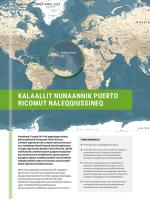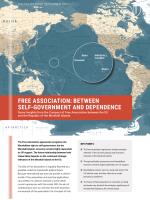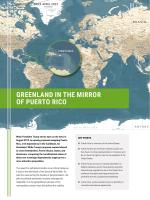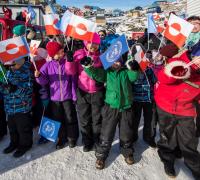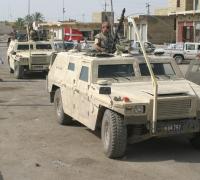Greenland in the mirror of Puerto Rico
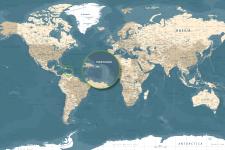
Read in Greenlandic (translation Tukummeq Maliina Møller-Steffens)
The quest for self-determination is as critical today as it was in the aftermath of the Second World War. As was the case during the heyday of decolonization, the path to political devolution remains entangled to realpolitik. It is the geopolitical calculus of the metropolitan centers that still defines the viability and feasibility of the
- Puerto Rico is a territory of the United States.
- Puerto Ricans are American citizens by birth, yet they have no voting representation in Congress and do not have the right to vote for the president of the United States.
- Puerto Rico’s economy is heavily dependent on federal subsidies, and its fiscal policies and debt restructuring negotiations are in the hands of an unelected oversight board appointed by the president and the congressional leadership.
- Puerto Rico, unlike Greenland, has no authority to conclude international agreements.
decolonizing formulas available to their non-sovereign territories. The options available to Greenland and Puerto Rico will no doubt reflect the new global order emerging from the ashes of Russia’s invasion of Ukraine, as the United States and Denmark (along with their NATO partners) engage in the complex task of redrawing and redefining the boundaries and security priorities of their transatlantic alliance.
It is precisely against this background that the present brief offers a succinct description of Puerto Rico’s politico-constitutional status. While bound to their respective metropoles within the context of contrasting constitutional arrangements, the political and legal issues besieging Greenland and Puerto Rico are not wholly dissimilar and deserve careful attention. More specifically, the definition of free association adopted by the US House of Representatives on December 15, 2022, upon approving the 2022 Puerto Rico Status Act bill, might prove informative to policymakers in Nuuk and Copenhagen.
Puerto Rico: Past and Present
After 400 years of Spanish colonial rule, Puerto Rico gravitated to the geopolitical orbit of the United States in the aftermath of the 1898 Spanish American War. By the end of the 19th century, America had come of age. Having absorbed Spain’s waning empire in the Caribbean and Asia, the United States soon annexed Puerto Rico, the Philippines and Guam. With the signing of the 1898 Paris Treaty, sovereignty over Puerto Rico (and its people) was placed in the hands of Congress – where it has since remained.
Population: 3,2 million (2023)
Size: 9.000 km2
Congressional representation: 1 non-voting delegate in the House of Representatives
Nationality: American citizenship at birth
GDP: 106,5 billion US Dollars (2022)
Federal subsidies:11,2 billion US Dollars (2022)
The 1898 Paris Treaty, parting ways with previous American treaty practice, did not make a promise of statehood to Puerto Rico nor did it extend American citizenship to its people. Instead, Article 9 of the Treaty vested in Congress plenary power to unilaterally determine the civil rights and political status of the people of Puerto Rico.
From the outset, the Supreme Court found in the so-called “Insular Cases” that the US Constitution did not apply in its entirety to Puerto Rico.
Congress’s extension of American citizenship to Puerto Ricans, which coincided with Washington’s entry into the First World War, came in 1917. Piecemeal reforms were further enacted by Congress in the aftermath of the Second World War. The elective governor, together with authorization to elect a local constitutional convention to draft an internal constitution, came at a time when a set of new geopolitical variables was also forcing London, Paris, and The Hague to reform their respective colonial ventures in the Caribbean, Africa, and Asia.
Puerto Rico, unlike Greenland, has no foreign relations authority to enter into agreements with foreign sovereigns or international organizations. Moreover, there is no institutional arrangement for appointing Puerto Rican representatives to the diplomatic missions of the United States to attend to Puerto Rican interests.
Puerto Rico’s removal from the list of UN territories in 1953, which now meant Washington was no longer required to report to the secretary-general on its running of the island, did not put an end to the debate surrounding the colonial nature of the island’s relationship with the United States.
In 1960, the UN General Assembly set forth three options for decolonisation: independence as a sovereign independent State, integration with another independent State, and Free Association with an independent State. Only five former colonies have opted for Free Association and each has a bespoke relationship with a former colonial power.
It was Puerto Rico’s bankruptcy crisis 63 years later (2015-16) that finally pierced the colonial veil. Congress’s enactment of the 2016 Puerto Rico Oversight, Management and Economic Stability Act (“PROMESA”) dispelled the myth broached in 1953 at the UN to the effect that Congress, following its ratification of the island’s local constitution, had relinquished its powers over Puerto Rico’s internal affairs. PROMESA, by voice of the Supreme Court, demonstrates the opposite. Having delegated Puerto Rico’s local governance to an unelected Oversight Board, without the consent of its people, PROMESA has effectively unmasked Puerto Rico’s colonial condition.
Puerto Rico is today a territory of the United States, subject to the plenary powers of Congress pursuant to the so-called Territorial Clause of the US Constitution.
The Territorial Clause establishes that Congress enjoys ample power “to dispose of and make all needful rules and regulations respecting the Territory or other Property belonging to the United States.”
Puerto Rico and Greenland: A Study in Contrasts
Although Puerto Rico and Greenland share a common citizenship with their respective metropoles, a closer look at their internal models of self-government amounts to a study in contrasts – due in no small measure to the structural differences separating the Danish and American constitutional orders.
Puerto Rico, unlike Greenland, has no foreign relations authority to enter into agreements with foreign sovereigns or international organizations. And, contrary to the 2009 Greenland Self-Government Act, Congress has never passed legislation providing for a consultation mechanism requiring the federal political branches in Washington to hear the territorial authorities in San Juan before signing and ratifying an international treaty that could run afoul of Puerto Rico’s most compelling interests. Moreover, there is no institutional arrangement for appointing Puerto Rican representatives to the diplomatic missions of the United States to attend to Puerto Rican interests.
In contrast with the Greenlandic landscape, Puerto Rico has no authority to engage in consultations with the political branches in Washington regarding the applicability on Puerto Rican soil of US laws that might have a prejudicial impact on the island. To the contrary, the federal laws enacted by Congress (and signed by the president) are fully applicable in Puerto Rico, despite the inescapable fact that the island has no representation in the Senate and only a non-voting delegate in the House of Representatives. And while the people of Puerto Rico elect their own governor and legislature every four years, Congress still retains overriding authority to nullify local legislation. In 2016, Congress passed PROMESA, delegating to an unelected oversight board vast authority to run the island’s fiscal affairs (including the restructuring of its staggering public debt).
1493: Christopher Columbus first sights Puerto Rico, claiming the island for the Spanish Crown.
1898: Spain cedes Puerto Rico to the United States.
1917: Congress confers American citizenship to the people of Puerto Rico.
1947: Congress grants the people of Puerto Rico the right to elect their own governor.
1952: The people of Puerto Rico inaugurate their local constitution.
1953: The UN General Assembly removes Puerto Rico from the list of dependent territories.
2016: Puerto Rico declares insolvency. Congress enacts the “Puerto Rico Oversight, Management, and Economic Stability Act.”
2022: The US House of Representative approves the 2022 Puerto Rico Status Act bill providing for a federally mandated plebiscite among non-territorial options: statehood, free association, and independence.
The free association model
Devoid of the necessary political authority for controlling the economic variables affecting its global competitiveness, and unable to articulate a sustainable economic model due to the regulatory straightjacket that comes with being a powerless territory, Puerto Rico requires a new political arrangement.
Bearing in mind that there appears to be no political will in Congress for admitting Puerto Rico as a State of the American Union, the time seems to be ripe for surveying the road to free association, as recently suggested by Congresswoman Nydia Velázquez (NY) and Ambassador Peter Rosenblatt, who played a key role in negotiating the current relationship of Micronesia, Palau, and Marshall Islands with the US.
Under the 2022 Puerto Rico Status Act bill, free association for this Caribbean island would mean acceding to full international sovereignty under international law. Washington’s overriding powers over Puerto Rico would cease, and its obligations under the 1898 Treaty of Paris would come to an end. All property, rights and interests the United States currently holds over Puerto Rico would be vested in the people of the island. Puerto Rico would exercise full control over its economic variables and, in the exercise of its newly acquired sovereignty, enter into a treaty of free association with the United States for regulating the terms of their new economic, diplomatic, security, and dual citizenship relationship. The treaty of free association would be susceptible to unilateral abrogation by either party.
For the opponents of free association, Puerto Rico’s chronic dependency on federal subsidies (particularly in the heels of Hurricane María 2017 and the COVID-19 crisis) makes this formula politically unviable. Their opposition is compounded by the fact that under free association Washington could, at any time, unilaterally sever its ties to Puerto Rico. For these voices, statehood, not free association, is the only formula that guarantees a permanent union with the United States.
The inauguration of a new Congress, on January 3, 2023, brought to a halt the status discussions that led to the approval in the House of Representatives of the 2022 Puerto Rico Status Act bill and its free association definition. Jumpstarting the status conversation will, therefore, require the introduction of new legislation.
Meanwhile, the proponents of free association for Puerto Rico should pay heed to the fact that similar to its approach in Micronesia, where the United States has engaged only recently in a renegotiation of its free association relationship with the Marshall Islands, Palau and the Federated States of Micronesia, driven in no small measure by the new geopolitical challenges posed by China and North Korea, the breadth and depth of a free association arrangement with Puerto Rico will also mirror the complexity of Washington’s geopolitical interests across the Western Hemisphere.

